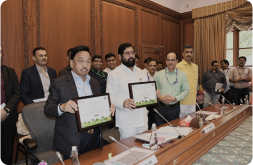










Project Target
0% Remaining
25,000
Trees Planted out of 25,000 Trees

Project Location:
The project supports the plantation of 25,000 local saplings in the community lands, particularly in forest areas of the villages of Devunivani, Thummala, Gorlevani, and Koneru of Srikakulam district in the state of Andhra Pradesh, India.
Project Aim
Trees provide locally accessible and appropriate nutrients to the community, thus forming an essential strategy to eliminate hunger (Pinstrup-Andersen, 2009). They deliver ecosystem services for crop production, provide better and more nutritionally-balanced diets and have greater control over food inputs the International Union of Forest Research Organizations (IUFRO) mentions in its Forests, Trees and Landscapes for Food Security and Nutrition A Global Assessment Report. Commission on Ecosystem Management (CEM) has identified Ecosystem Restoration as one of its 19 priority thematic areas. This includes an ecologically inclusive approach to developmental procedures. The Society for Ecological Restoration says that development is incomplete without the inclusion of the ecology and promotion of sustainable development. Plantation of mixed species balances the nutrient content of the soil, increases the nitrogen-fixing capability of the soil, produces root exudates that advantage another, protects from pests and disease, etc. Also, the provision of NTFPs, forms an important source of income for the community.
Tamarind (Tamarindus indica), Neem (Azadirachta indica), Jamun (Syzygium cumini), Peepal (Ficus religiosa) and Indian Tulip (Thespesia populnea).
The project intends to provide local employment opportunities to the local population, particularly tribals and women. The restoration activities of the plantation area including the plantation work, weeding and hoeing of the saplings planted will provide an additional source of income to the local people. The project will also improve the access of local communities to the collection of fuelwood and minor forest produces, thereby contributing to improving their household income. The NTFPs from the forest will provide both income and food to the rural communities. The communities living at the periphery of the forests are heavily dependent on the forest for most of their needs, which include food security. The planted trees being mixed species and many of them producing fruits will cater to this need of the community.
The increased vegetation in the region will help not just in controlling soil erosion but improve moisture conservation, add organic humus to the soil and enhance the water table in the region. The plantation of mixed species will further enrich the soil nutrients enhancing the agricultural produce.
Social Impact of Growing Trees
Community Engagement
Tree planting initiatives often involve local communities, which can lead to greater community cohesion.
Ecological Education
Provides opportunities for community members, especially children, about the importance of environmental sustainability.
Urban Beautification
Trees contribute to the aesthetic enhancement of urban areas, making cities more pleasant and liveable.
Climate Resilience
By improving green cover, tree planting helps make communities more resilient against climate impacts like heatwaves.
Employment Creation
Planting trees creates employment for local community members like planting and maintenance, administrative roles, and more long-term jobs in management.
Wildlife Habitat
Trees provide critical habitats for various species of wildlife. Enhancing tree cover helps preserve biodiversity, which can be an ecological boon for local communities
Copyrights @ 2025 All rights reserved by Pangea EcoNetAssets Pvt Ltd.